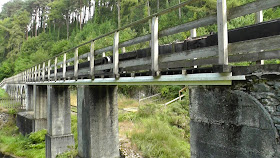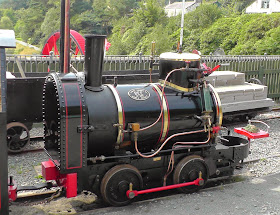 In a nutshell
In a nutshell
Gauge: 19” (483mm)
Length: ¼ mile
Opened: 1823 (manual power)
1827 (horse power)
1877 (steam power)
1929 Mine and railway closed
2004 Re-opened with replicas of original locomotives
Location and route:
 |
| Source: http://www.laxeyminerailway.im/top/where-to-find-us/ |
Great Laxey Mine Railway
12 Rosslyn Terrace
Ballaquayle Road
Douglas
Isle of Man
IM2 5DE
Email: minerailway@manx.net
Date of visit: 26 July 2014
Key Facts
- The railway was built to serve the Great Laxey Lead Mine
- With a gauge of 19", it is unique in the British Isles
- The famous Lady Isabella water wheel was used to pump water from the mine workings
- The main entrance to the mine was through an adit which located near the further end of the Great Laxey Mine Railway
- The adit stretched for a distance of 1½ miles into the mountain. It provided access to a series of shafts which led down to the mine workings. The ore from the workings was raised to the level of the adit and then taken out along the tramway to be treated in the washing floors
- At its peak, the mine produced more ore than all the rest of the UK lead mines put together
- After using manpower and then ponies for the first fifty years of of the tramway's existence, two diminutive steam locomotives, Ant and Bee, were constructed by Stephen Lewins of Poole, in Dorset.
- These two locomotives provided the motive power for the railway, being refurbished by Bagnalls in 1905. They were scrapped in 1935.
- Restoration of the railway was proposed by the Laxey and Lonan Heritage Trust in May 1998. Work commenced in 2000 and the railway was completed in 2004
- The replica locomotives, Ant and Bee were built by Great Northern Steam Ltd of Darlington. Ant was refurbished by Alan Keef Ltd in 2007 and Bee was refurbished in 2008/9 by volunteers. They were both reboilered in 2011
- The railway also has a battery electric locomotive, Wasp, which was built in 1973 by Clayton Equipment Co Ltd. It was refurbished and regauged from 18 inches to 19 inches by Alan Keef Ltd in 2009.
- Two passengers carriages were specially built for the railway by Alan Keef Ltd and delivered to the railway in 2004 and 2007
- The line also has six replica ore wagons which were built by The Laxey Blacksmith in 2000
- The railway is open at weekends during the summer months and is run by volunteers.
My Impressions
The station is located a short walk away from the Manx Electric Railway station just below the road and railway on the Ramsey side of the town. The station is a modest affair but serves its purpose well.Our loco for the day was Bee. She was steaming quietly on the station siding, hitched to one of the passenger coaches and awaiting its passengers.
The specially-built coach with its bench seating was designed to squeeze into the Isle of Man's only railway tunnel which is just behind the station.
I bought my ticket in the railway's ticket office and boarded the train. Once the carriage was full to its capacity of 10 passengers, we set off Down the line. Taking a 90 degree left hand bend we entered the tunnel
The tunnel is approximately 70 metres in length and its restricted size provided a clue as to the diminutive proportions of the coach and the locomotives.
After emerging once more into the daylight, the railway winds its way along the valley, following for the most part the route of the original railway,
....... passing the entrance to the adit which was the main access route into the mine.
The station, Cronk y Chuil, at the upper end of the line, has basic facilities - a siding, a small shelter and a picnic site, with access to a copper mine trail.
On the siding were some of the replica mine tubs which transported the ore from the adit to the washing floors.
The locomotive and some of the passengers waited patiently on the main line .....
..... and after around ten minutes, they departed. As can be seen, the facilities provided for the driver are minimal - but the nautical boiler is very simplistic and required stoking with pieces of timber fairly infrequently.
I walked up the short footpath to visit the Great Laxey Wheel which was used to pump water from the mine workings below. The wheel itself is somewhat impressive, turning slowly with a gentle majesty.
There are plenty of walks and trails around the wheel for those wishing to explore further.
I was particularly interested in the mechanism which connects the wheel to the pumping apparatus. From the centre of the wheel, a large crank is attached to a connecting rod .........
..... which is supported on a long viaduct
...... until eventually connecting with a rocking bell-crank mechanism which presumably operates the pistons of pumps located below ground level.
I then made my way back down the path to the station and awaited the arrival of the train. There was time to read some of the information boards which gave some background to the mine workings
......... and the role of the railway.
Strolling back up the railway, I studied the trackwork and ........
..... pointwork which was reminiscent of the lightweight rail sections used during World War I.
The train arrived with a new set of passengers and I squeezed into the carriage for the return journey.
On arrival at the main station, I wandered over to the sheds to see Bee's sister engine, Ant .....
These remarkable little engines would be ideal in helping the uninitiated to understand the workings of a steam engine. The front-mounted water-tank is particularly noteworthy in how to cram a quart into a pint-pot - almost literally.
On the neighbouring siding was the line's Clayton battery electric, loco, Wasp. Another masterpiece in compact engineering.
Returning to the main platform road, I took a lingering look at Bee.....
...... before walking over to Lady Isabella's smaller sister, the recently restored Lady Evelyn water wheel.
I then made my way back to the Manx Electric Railway station for my journey back to Douglas.
The Great Laxey Mine Railway and its locomotives have been lovingly recreated by a dedicated group of volunteers. Not only is the railway itself unique in its unusual gauge, it is difficult to imagine where else there would be an opportunity to see steam locomotives of this size and design in operation. The railway fulfils several purposes - it provides a means of transport but more importantly it provides an insight into the ingenuity and imagination of Victorian engineers in making use of available technology to solve problems. I am glad I extended my stay on the island to seek out and experience this unique little railway.
The tunnel is approximately 70 metres in length and its restricted size provided a clue as to the diminutive proportions of the coach and the locomotives.
After emerging once more into the daylight, the railway winds its way along the valley, following for the most part the route of the original railway,
....... passing the entrance to the adit which was the main access route into the mine.
The station, Cronk y Chuil, at the upper end of the line, has basic facilities - a siding, a small shelter and a picnic site, with access to a copper mine trail.
On the siding were some of the replica mine tubs which transported the ore from the adit to the washing floors.
The locomotive and some of the passengers waited patiently on the main line .....
..... and after around ten minutes, they departed. As can be seen, the facilities provided for the driver are minimal - but the nautical boiler is very simplistic and required stoking with pieces of timber fairly infrequently.
I walked up the short footpath to visit the Great Laxey Wheel which was used to pump water from the mine workings below. The wheel itself is somewhat impressive, turning slowly with a gentle majesty.
There are plenty of walks and trails around the wheel for those wishing to explore further.
I was particularly interested in the mechanism which connects the wheel to the pumping apparatus. From the centre of the wheel, a large crank is attached to a connecting rod .........
..... which is supported on a long viaduct
...... until eventually connecting with a rocking bell-crank mechanism which presumably operates the pistons of pumps located below ground level.
I then made my way back down the path to the station and awaited the arrival of the train. There was time to read some of the information boards which gave some background to the mine workings
......... and the role of the railway.
Strolling back up the railway, I studied the trackwork and ........
..... pointwork which was reminiscent of the lightweight rail sections used during World War I.
The train arrived with a new set of passengers and I squeezed into the carriage for the return journey.
On arrival at the main station, I wandered over to the sheds to see Bee's sister engine, Ant .....
These remarkable little engines would be ideal in helping the uninitiated to understand the workings of a steam engine. The front-mounted water-tank is particularly noteworthy in how to cram a quart into a pint-pot - almost literally.
On the neighbouring siding was the line's Clayton battery electric, loco, Wasp. Another masterpiece in compact engineering.
Returning to the main platform road, I took a lingering look at Bee.....
...... before walking over to Lady Isabella's smaller sister, the recently restored Lady Evelyn water wheel.
I then made my way back to the Manx Electric Railway station for my journey back to Douglas.
The Great Laxey Mine Railway and its locomotives have been lovingly recreated by a dedicated group of volunteers. Not only is the railway itself unique in its unusual gauge, it is difficult to imagine where else there would be an opportunity to see steam locomotives of this size and design in operation. The railway fulfils several purposes - it provides a means of transport but more importantly it provides an insight into the ingenuity and imagination of Victorian engineers in making use of available technology to solve problems. I am glad I extended my stay on the island to seek out and experience this unique little railway.
Video
[In preparation]



























No comments:
Post a Comment